To calculate payback time for Vertical Axis Wind Turbines (VAWTs), you'll need to assess several key factors. Start by estimating energy output using historical wind data and power curves. Factor in initial costs, including equipment, installation, and permitting fees. Don't forget ongoing maintenance expenses and local electricity rates. Consider government incentives and rebates that can offset costs. Evaluate your local wind resources and turbine efficiency to predict annual energy production. Finally, divide your total investment by the annual energy savings to determine the payback period. Keep in mind that lifespan, energy storage options, and grid connection choices can greatly impact your calculations. Digging deeper into these elements will help you make a more informed decision.
Understanding Vertical Axis Wind Turbines
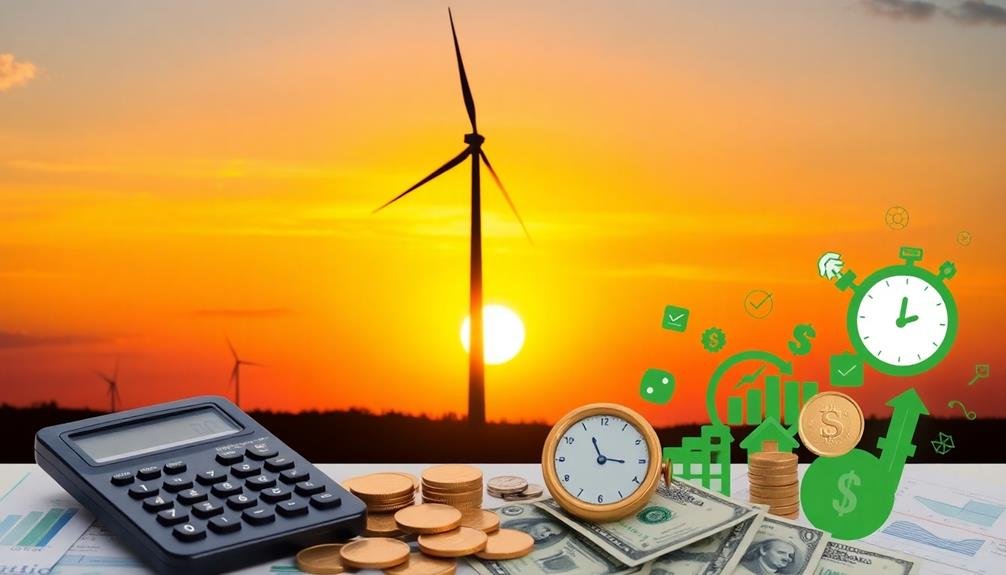
Vertical axis wind turbines (VAWTs) stand out from their horizontal counterparts in both form and function. Unlike traditional horizontal axis turbines, VAWTs rotate around a vertical shaft, allowing them to capture wind from any direction without needing to reorient themselves. This design makes them particularly suitable for urban environments and areas with turbulent wind patterns.
You'll find two main types of VAWTs: Darrieus and Savonius. Darrieus turbines resemble eggbeaters and use lift forces to rotate, while Savonius turbines look like split cylinders and rely on drag forces. Each type has its advantages: Darrieus turbines are more efficient at higher wind speeds, while Savonius turbines perform better in low wind conditions and are simpler to construct.
VAWTs offer several benefits, including lower noise levels, reduced visual impact, and easier maintenance due to their ground-level gearboxes and generators. They're also safer for birds and bats compared to horizontal axis turbines.
However, VAWTs generally have lower efficiency rates and may experience more turbulence-induced vibrations. When calculating payback time, you'll need to take into account these factors alongside initial costs, energy output, and local wind conditions.
Energy Output Estimation Methods
When estimating a wind turbine's energy output, you'll need to employ various methods to get an accurate prediction. Start by gathering historical wind data for your specific location, including wind speed and direction. You'll want at least a year's worth of data to account for seasonal variations.
Next, use the turbine's power curve, which shows the relationship between wind speed and power output. This information is typically provided by the manufacturer. Combine this with your wind data to calculate potential energy production.
Don't forget to factor in the turbine's height, as wind speed increases with altitude. You'll need to adjust your wind data accordingly using the wind shear coefficient for your area.
Consider using specialized software like HOMER or WindPRO to streamline these calculations. These tools can integrate multiple data points and provide detailed simulations.
Lastly, apply a capacity factor to account for real-world inefficiencies. This factor, usually between 20-40% for vertical axis turbines, helps adjust your estimates for maintenance downtime, turbulence, and other factors that reduce actual output compared to theoretical maximum production.
Initial Investment Costs
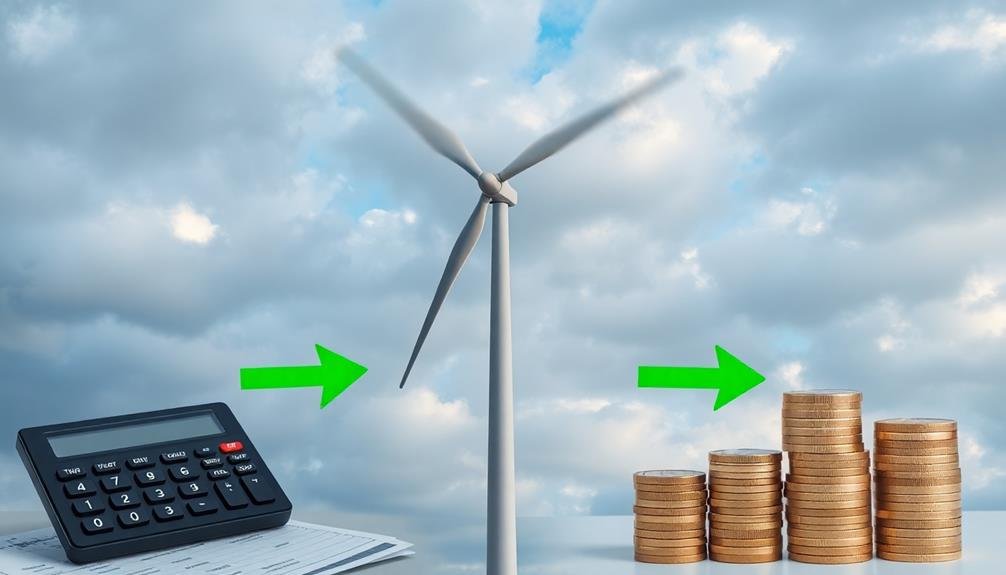
When calculating the payback time for wind turbines, you'll need to contemplate several initial investment costs.
You'll encounter expenses for equipment and installation, which often form the bulk of your investment.
Additionally, you must factor in site preparation costs and budget for permitting and legal fees, which can vary greatly depending on your location and project scale.
Equipment and Installation Expenses
Considering the substantial upfront costs, equipment and installation expenses form a considerable portion of the initial investment for wind turbines.
You'll need to account for the turbine itself, which includes the rotor, generator, and tower. Prices vary widely based on size and capacity, ranging from $10,000 for small residential turbines to millions for large commercial units.
Installation costs can be just as hefty. You'll need to factor in site preparation, foundation construction, and transportation of equipment.
Don't forget about the crane rental for erecting the turbine, which can cost thousands per day. Electrical components, such as inverters and grid connection equipment, also add to your expenses.
You'll likely need to hire specialized technicians for installation, which can notably impact your budget. Permitting and inspections are additional costs you can't overlook.
If you're installing offshore, expect even higher expenses due to marine construction challenges.
Site Preparation Costs
Beyond the turbine itself, site preparation costs can considerably impact your initial investment. You'll need to account for various expenses related to getting your chosen location ready for turbine installation. These costs can vary widely depending on your site's specific characteristics and local regulations.
Here's a breakdown of common site preparation expenses:
| Expense Category | Typical Range |
|---|---|
| Land clearing | $500 – $5,000 |
| Soil testing | $800 – $2,000 |
| Foundation work | $3,000 – $15,000 |
| Access road | $2,000 – $10,000 |
| Electrical work | $1,500 – $8,000 |
You'll likely need to clear vegetation and level the ground where your turbine will stand. Soil testing is essential to guarantee the site can support the turbine's weight and withstand potential vibrations. Foundation work involves creating a stable base, often using concrete. If your site isn't easily accessible, you may need to construct an access road for equipment and maintenance. Finally, don't forget about electrical work, including wiring and grid connection costs. Remember, these figures are estimates, and your actual expenses may vary based on your location and specific project requirements.
Permitting and Legal Fees
Permitting and legal fees form another significant part of your initial investment in a wind turbine project. These costs can vary widely depending on your location, local regulations, and the complexity of your project.
You'll need to obtain various permits, including construction permits, environmental impact assessments, and zoning approvals.
Legal fees may include expenses for contract reviews, land lease agreements, and maneuvering local ordinances. Some areas have strict regulations on wind turbine height, noise levels, and setback distances from property lines.
You might need to hire an attorney specializing in renewable energy projects to guarantee compliance with all applicable laws.
Don't forget about interconnection agreements with your local utility company. These can be complex and may require legal expertise to negotiate favorable terms.
Additionally, you may need to secure rights-of-way for power lines if your turbine isn't directly connected to your property.
To minimize these costs, research your local regulations thoroughly before starting your project.
Consider working with experienced consultants who can guide you through the permitting process and help you anticipate potential legal challenges.
While these fees can be substantial, proper planning can help you avoid costly delays and guarantee your wind turbine project proceeds smoothly.
Ongoing Maintenance Expenses
Numerous ongoing maintenance expenses impact the payback time of wind turbines.
You'll need to factor in regular inspections, which typically occur annually or semi-annually. These checks guarantee that all components are functioning correctly and help prevent costly breakdowns.
Blade maintenance is a significant expense. You'll need to clean and repair the blades periodically to maintain peak performance.
Gearbox maintenance, including oil changes and gear inspections, is another recurring cost you can't ignore.
You'll also face expenses for replacing worn-out parts. Components like bearings, seals, and brake pads have limited lifespans and require periodic replacement.
Electrical system maintenance, including checks on generators and control systems, is essential for keeping your turbine operational.
Don't forget about unexpected repairs. Despite regular maintenance, you may encounter sudden failures that require immediate attention. These can be costly and unpredictable.
Lastly, consider the expenses related to monitoring systems. You'll need to maintain and upgrade software and hardware that track your turbine's performance and alert you to potential issues.
Local Wind Resource Assessment
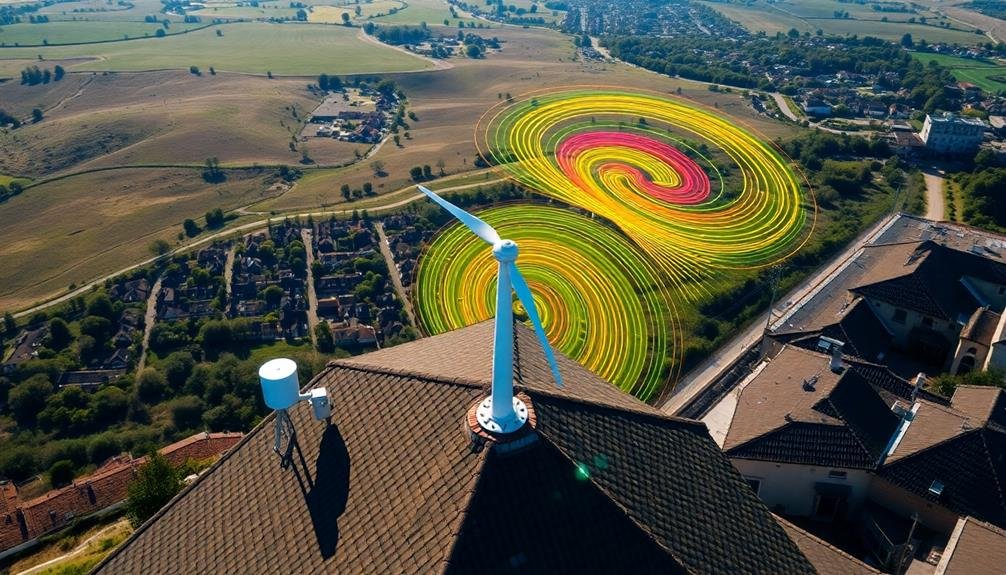
A critical step in calculating payback time for wind turbines is conducting a thorough local wind resource assessment. You'll need to gather data on wind speeds, direction, and frequency at your specific location. This information is essential for estimating potential energy production and, ultimately, the financial viability of your turbine investment.
To perform a wind resource assessment, you'll typically use anemometers and wind vanes mounted on a meteorological tower. These instruments collect data over an extended period, usually a year or more, to account for seasonal variations. You can also consult wind maps and databases, but on-site measurements are more accurate for your specific location.
Here's a breakdown of key factors to take into account in your wind resource assessment:
| Factor | Importance | Impact on Payback Time |
|---|---|---|
| Average Wind Speed | High | Directly affects energy output |
| Wind Direction | Medium | Influences turbine placement |
| Wind Shear | Medium | Affects turbine height choice |
| Turbulence | High | Can reduce turbine efficiency |
| Seasonal Variations | Medium | Impacts annual energy production |
Electricity Rate Considerations
With your wind resource assessment complete, you'll need to factor in electricity rates to accurately calculate your wind turbine's payback time. Start by determining your current electricity rate, which you can find on your utility bill. It's typically expressed in cents per kilowatt-hour (kWh).
Remember that rates often vary by season, time of day, or consumption level.
Next, research future rate projections for your area. Many utilities plan rate increases over time, which can greatly impact your payback calculations. Consider historical rate trends and any announced future changes.
You'll also want to investigate net metering policies in your region. These determine how much credit you'll receive for excess electricity your turbine feeds back into the grid.
Don't forget to account for demand charges if you're a commercial customer. These fees, based on your peak energy usage, can considerably affect your overall electricity costs.
Finally, explore any available renewable energy incentives or tax credits that could offset your initial investment.
Government Incentives and Rebates

Government incentives and rebates can greatly impact the payback time for your wind turbine investment. These financial benefits come in various forms, including tax credits, grants, and performance-based incentives.
The federal government offers a Production Tax Credit (PTC) for wind energy, which provides a per-kilowatt-hour tax credit for electricity generated by wind turbines. This credit can considerably reduce your overall costs and shorten your payback period.
Many states also offer their own incentives, such as property tax exemptions, sales tax exemptions, or rebates for wind energy systems. You'll need to research the specific programs available in your area, as they can vary widely.
Some utility companies provide additional rebates or net metering programs, allowing you to sell excess electricity back to the grid.
When calculating your payback time, factor in all applicable incentives and rebates. This may involve consulting with a tax professional or renewable energy expert to verify you're taking full advantage of available programs.
Remember that incentives can change over time, so stay informed about current offerings and deadlines. By leveraging these financial benefits, you can accelerate your return on investment and make wind energy more economically viable for your situation.
Turbine Efficiency Factors
Turbine efficiency factors play an imperative role in determining your wind energy system's performance and payback time. Several key elements affect your turbine's efficiency, including its design, size, and placement.
The rotor's swept area, which is the total area covered by the blades as they rotate, directly impacts power output. Larger swept areas generally produce more electricity.
Your turbine's cut-in speed, the wind velocity at which it starts generating power, is vital. Lower cut-in speeds mean more operational time and increased energy production. The turbine's rated speed and capacity factor also influence efficiency. A higher capacity factor indicates better performance across various wind conditions.
Don't overlook the importance of proper siting. Placing your turbine in an area with consistent, unobstructed wind flow can greatly enhance its efficiency. Consider factors like terrain, nearby buildings, and local wind patterns when choosing a location.
Regular maintenance is vital to maintain peak efficiency. Keep blades clean and balanced, and verify all components are in good working order.
Grid Connection vs. Off-Grid Systems
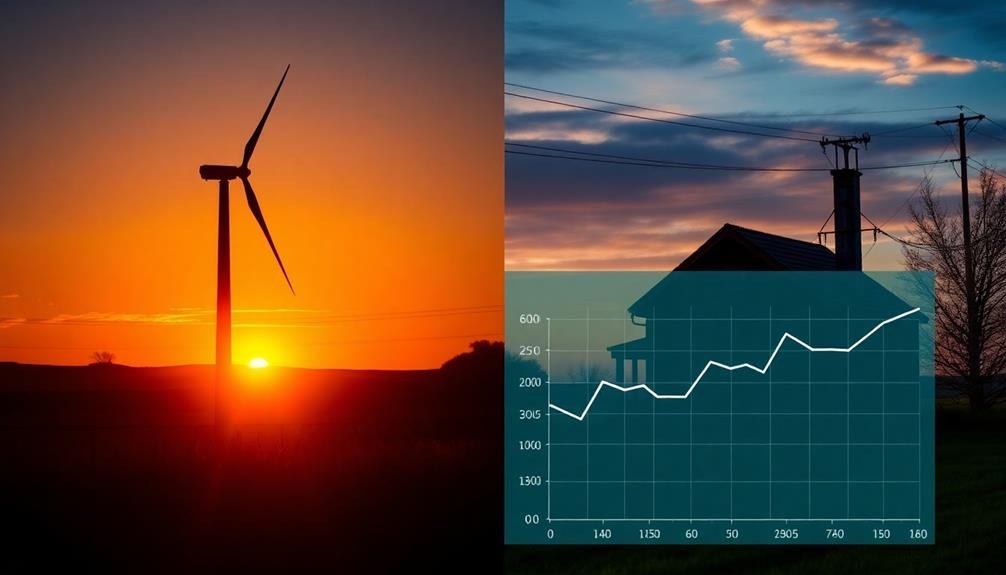
When considering wind turbines, you'll need to decide between grid-connected and off-grid systems. Grid-connected turbines feed excess power back to the utility grid, potentially earning you credits or payments. Off-grid systems, on the other hand, store energy in batteries for later use, making them ideal for remote locations.
Grid-connected systems typically have lower upfront costs and maintenance requirements. You won't need to invest in expensive battery banks or manage energy storage. However, you'll still rely on the grid during low-wind periods and may face utility regulations.
Off-grid systems offer energy independence but require more components and careful planning. You'll need to size your system to meet your energy needs, including battery storage for periods of low wind. While this increases initial costs, you'll be free from utility bills and grid outages.
Here's a comparison of key factors:
| Factor | Grid-Connected | Off-Grid |
|---|---|---|
| Initial Cost | Lower | Higher |
| Maintenance | Less | More |
| Energy Independence | Partial | Full |
| Complexity | Simpler | More complex |
| Payback Time | Generally faster | Usually longer |
Consider your location, energy needs, and budget when choosing between these options. Each has its advantages, and the right choice depends on your specific circumstances.
Lifespan of VAWT Components
Durability is a key factor when considering Vertical Axis Wind Turbines (VAWTs). You'll find that the lifespan of VAWT components varies depending on their quality, maintenance, and environmental conditions. The main components include the rotor, generator, bearings, and support structure.
The rotor blades, typically made of composite materials, can last 10-20 years with proper care. However, they're susceptible to fatigue and environmental damage.
Your generator's lifespan ranges from 15-25 years, depending on its design and protection from the elements. Bearings are essential components that may need replacement every 5-10 years, as they're subject to constant stress and wear.
The support structure, often made of steel or aluminum, can last 20-30 years with proper corrosion protection. You'll need to factor in regular maintenance and potential component replacements when calculating the overall lifespan of your VAWT system.
Environmental factors like salt air, extreme temperatures, and high winds can greatly impact component longevity.
Energy Storage Options
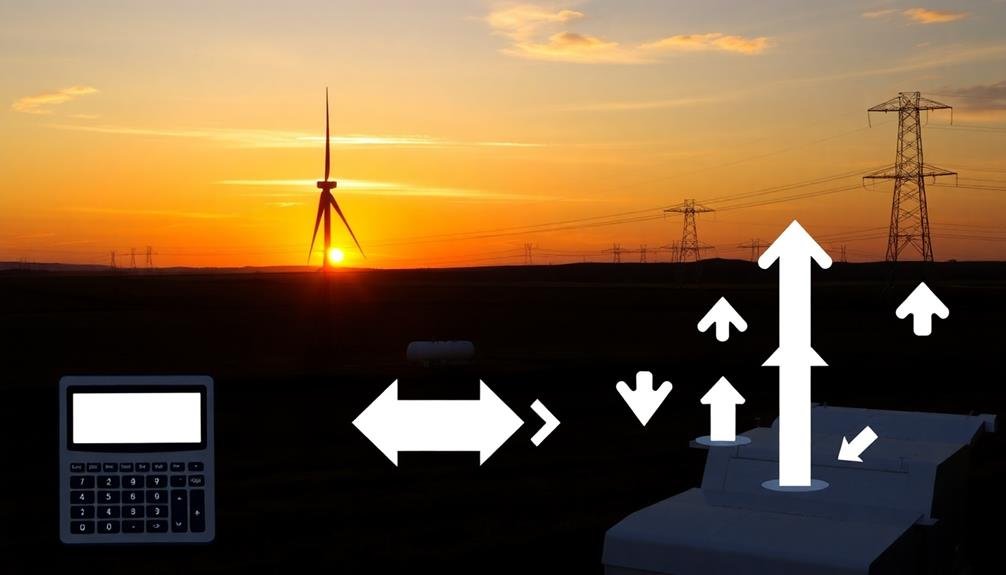
When calculating the payback time for wind turbines, you'll need to contemplate energy storage options.
You can explore battery storage systems, which offer scalable and increasingly cost-effective solutions for storing excess wind energy.
Additionally, you might investigate flywheel energy storage for short-term power management or hydrogen fuel cells for long-duration storage capabilities.
Battery Storage Systems
Many wind turbine installations now incorporate battery storage systems to enhance their efficiency and reliability. These systems allow you to store excess energy generated during high-wind periods for use when the wind is calm. You'll find various battery types available, each with its own advantages and considerations.
When selecting a battery storage system for your wind turbine, consider factors like capacity, cycle life, and cost. Here's a comparison of common battery types:
| Battery Type | Capacity | Cycle Life | Cost | Efficiency |
|---|---|---|---|---|
| Lead-Acid | Moderate | 500-1000 | Low | 80-85% |
| Lithium-Ion | High | 2000-5000 | High | 90-95% |
| Flow | Very High | 10000+ | High | 65-75% |
| Sodium-Sulfur | High | 2500-4500 | High | 75-85% |
| Nickel-Cadmium | Moderate | 1000-2000 | Moderate | 65-75% |
You'll need to calculate the required storage capacity based on your turbine's output and your energy needs. Don't forget to factor in the depth of discharge, which affects the battery's lifespan. Regular maintenance is essential to maximize your battery system's performance and longevity. By properly sizing and maintaining your battery storage system, you'll greatly improve your wind turbine's payback time and overall efficiency.
Flywheel Energy Storage
While battery storage systems are popular, another innovative energy storage option for wind turbines is flywheel technology. Flywheels store energy by spinning a rotor at high speeds, converting electrical energy into kinetic energy. When power is needed, the flywheel's rotation is slowed down, converting the kinetic energy back into electricity.
Flywheels offer several advantages for wind turbine energy storage:
- Rapid response time: They can quickly absorb excess energy and release it when demand increases.
- Long lifespan: Flywheels can endure millions of charge-discharge cycles without significant degradation.
- Low maintenance: They require minimal upkeep compared to chemical batteries.
You'll find that flywheels are particularly useful for short-term energy storage and grid stabilization. They can help smooth out power fluctuations caused by wind variability, ensuring a more consistent energy supply.
However, flywheels aren't ideal for long-term storage due to their gradual energy loss through friction.
When calculating the payback time for your wind turbine project, consider the initial cost of flywheel systems against their operational benefits. While they may have a higher upfront cost than some alternatives, their efficiency and longevity can lead to significant long-term savings.
Hydrogen Fuel Cells
A third energy storage option for wind turbines is hydrogen fuel cells. These devices convert hydrogen into electricity through an electrochemical process, offering a clean and efficient way to store excess wind energy. When your turbine generates more power than needed, you can use electrolysis to split water into hydrogen and oxygen. The hydrogen is then stored for later use in fuel cells.
Hydrogen fuel cells have several advantages for wind energy storage. They're scalable, allowing you to store large amounts of energy for extended periods. They also have a high energy density, meaning you can store more power in a smaller space compared to batteries. However, they do have some drawbacks, including higher initial costs and lower round-trip efficiency.
Here's a comparison of hydrogen fuel cells with other storage options:
| Feature | Batteries | Flywheels | Hydrogen Fuel Cells |
|---|---|---|---|
| Capacity | Medium | Low | High |
| Lifespan | 5-15 years | 15-20 years | 20+ years |
| Efficiency | 80-90% | 70-80% | 40-60% |
| Response Time | Fast | Very Fast | Moderate |
| Environmental Impact | Moderate | Low | Low |
Consider these factors when deciding if hydrogen fuel cells are the right storage solution for your wind turbine system.
Return on Investment Calculation
Return on Investment (ROI) calculation is a essential step in determining a wind turbine's financial viability. To calculate ROI for your vertical axis wind turbine, you'll need to evaluate several factors, including initial costs, energy production, and ongoing expenses.
Start by estimating your turbine's annual energy output in kilowatt-hours (kWh) and multiply it by your local electricity rate to determine yearly savings.
Next, factor in these key elements:
- Initial investment: Include the turbine's cost, installation fees, and any necessary permits or infrastructure upgrades.
- Annual maintenance costs: Account for regular inspections, repairs, and component replacements.
- Expected lifespan: Most wind turbines last 20-25 years, but this can vary based on environmental conditions and maintenance.
Subtract your annual maintenance costs from your yearly savings to find your net annual benefit.
Divide your initial investment by this net annual benefit to determine the payback period in years. To calculate ROI as a percentage, divide your net annual benefit by the initial investment and multiply by 100.
Factors Affecting Payback Time
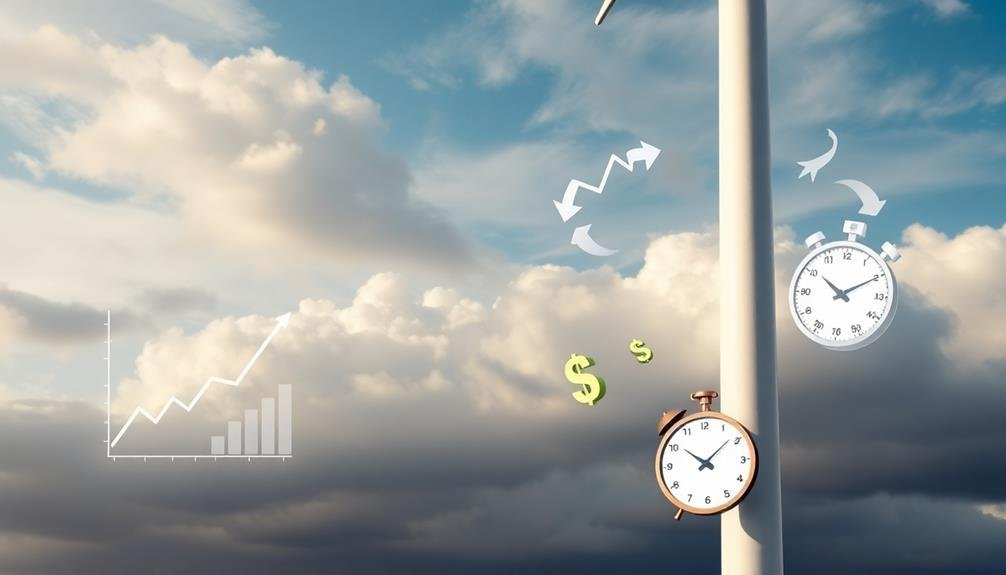
When calculating the payback time for wind turbines, you'll need to take into account several key factors.
Your initial installation costs, including equipment and construction, will greatly impact how long it takes to recoup your investment.
You must also account for the turbine's energy production capacity and ongoing expenses like maintenance and repairs, as these will affect your long-term financial returns.
Initial Installation Costs
Initial installation costs play an essential role in determining the payback time for wind turbines. These upfront expenses can vary greatly based on factors such as turbine size, location, and infrastructure requirements.
When considering the initial costs, you'll need to account for the turbine itself, transportation, site preparation, and installation.
The turbine's price typically constitutes the largest portion of your investment. Larger turbines with higher power outputs generally cost more but may offer better long-term returns.
You'll also need to factor in:
- Site assessment and permitting fees
- Foundation construction and tower erection costs
- Electrical system installation and grid connection expenses
Don't forget to include the cost of auxiliary equipment like inverters, batteries (for off-grid systems), and monitoring devices.
Labor costs can vary depending on your location and the complexity of the installation. If you're installing the turbine in a remote area, you may face additional expenses for transportation and specialized equipment rental.
It's vital to obtain detailed quotes from reputable suppliers and installers to get an accurate estimate of your initial costs. This information will help you calculate a more precise payback period for your wind turbine investment.
Energy Production Capacity
The powerhouse of your wind turbine investment lies in its energy production capacity. This vital factor determines how much electricity your turbine can generate over time, directly impacting its payback period. To accurately assess this capacity, you'll need to take into account several key elements.
First, examine the turbine's power curve, which shows its energy output at different wind speeds. You'll want a turbine that performs well in your area's typical wind conditions.
Next, factor in the turbine's rated capacity, usually measured in kilowatts (kW). This indicates its maximum power output under ideal conditions.
Don't forget to account for your location's wind resource. Higher average wind speeds will lead to greater energy production. You should also take into account seasonal variations, as wind patterns can change throughout the year.
The turbine's efficiency is another vital aspect. Modern designs often incorporate features like improved blade shapes or advanced generators to maximize energy capture.
Additionally, take note of the turbine's cut-in and cut-out wind speeds, which define the range of wind speeds at which it can operate safely and efficiently.
Lastly, factor in any potential obstructions or turbulence sources nearby that could affect wind flow and reduce energy production.
Maintenance and Repairs
While energy production capacity determines your wind turbine's potential earnings, maintenance and repair costs can greatly impact its payback time. Regular upkeep is essential to guarantee your turbine operates efficiently and avoids costly breakdowns.
You'll need to factor in routine maintenance expenses, such as lubricating moving parts, tightening bolts, and inspecting blades for damage.
Unexpected repairs can considerably extend your payback period. Common issues include:
- Blade damage from debris or extreme weather
- Generator malfunction due to electrical issues
- Bearing wear and tear, requiring replacement
To minimize these costs, consider investing in a high-quality turbine with a robust warranty.
It's also wise to budget for annual maintenance and set aside an emergency fund for repairs. You can reduce expenses by learning to perform basic maintenance tasks yourself, but always consult professionals for complex issues.
Frequently Asked Questions
How Do VAWTS Compare to Traditional Horizontal Axis Wind Turbines?
You'll find VAWTs have some advantages over traditional horizontal turbines. They're omnidirectional, work in turbulent winds, and are quieter. However, they're generally less efficient and produce less power than their horizontal counterparts in most conditions.
Are VAWTS Suitable for Urban or Residential Installations?
You'll find VAWTs suitable for urban and residential areas. They're quieter, work well with turbulent winds, and have a smaller footprint. They're safer for birds and look more aesthetically pleasing in tight spaces than traditional turbines.
What Are the Noise Levels Produced by Vertical Axis Wind Turbines?
You'll find that vertical axis wind turbines are generally quieter than their horizontal counterparts. They produce low-frequency noise, typically below 60 decibels at close range. This makes them more suitable for urban and residential installations.
Can VAWTS Be Integrated With Solar Panels for Hybrid Energy Systems?
Yes, you can integrate VAWTs with solar panels to create hybrid energy systems. You'll benefit from complementary power generation, as wind often blows when the sun isn't shining. This combination maximizes energy production and system efficiency.
How Do Extreme Weather Conditions Affect VAWT Performance and Longevity?
You'll find that extreme weather can considerably impact VAWT performance and lifespan. High winds may damage components, while icing can reduce efficiency. However, VAWTs are often more resilient to turbulent conditions than horizontal-axis turbines.
In Summary
You've now got the tools to calculate the payback time for your vertical axis wind turbine. Remember, it's not just about initial costs—factor in energy output, maintenance, local wind conditions, and component lifespan. Don't forget to take into account energy storage options. By crunching these numbers, you'll determine your return on investment and understand what impacts your payback period. With this knowledge, you can make an informed decision about VAWT installation.

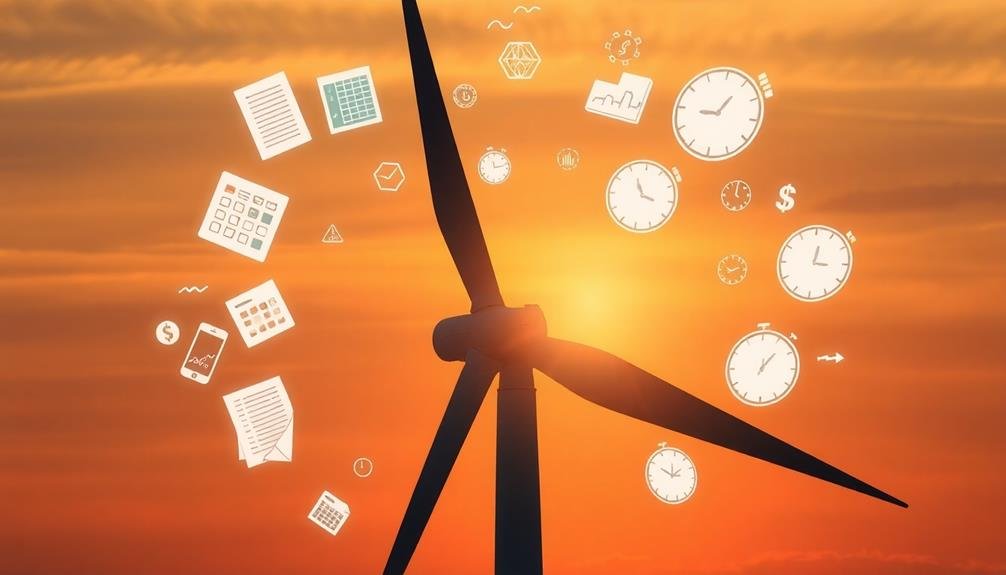

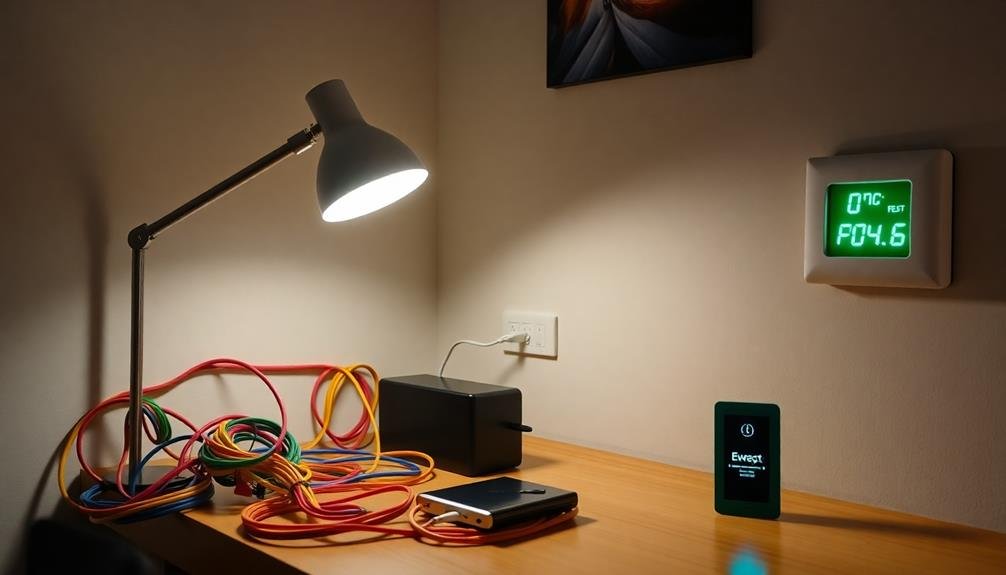

Leave a Reply